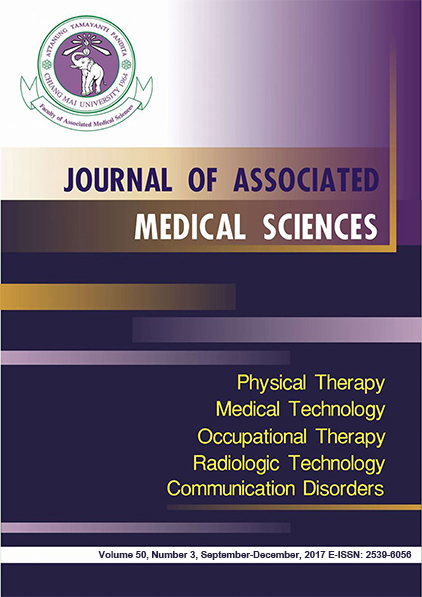Evaluation of effective doses in CT simulation using CTDIw calculation
Main Article Content
Abstract
Background: Computed Tomography (CT) simulator is used for primary imaging in Department of Radiation Therapy.
Although it is also the leading standard of treatment planning since it directly measures electron densities needed for dosage computation, it is known to deliver more radiation dose to patients.
Objectives: The purpose of this study is to determine the effective dose for cancer patients undergoing the CT simulator.
Materials and methods: An ionization chamber was used to measure CTDIair in CT simulator (Siemens, Somatom Definition AS, Germany). Measurement of CTDIw was done by placing the Pencil Ionization Chamber (Radcal, USA, SN:05-0340) in PMMA head and body phantoms to measure CTDI100 for the head and abdomen region, respectively. Twenty cases of head, thorax, and pelvic cancer patients were recorded. CTDIvol, DLP, scan length, kV, mAs, pitch, and rotation time parameters were collected in each patient for CTDIw dose calculation to obtain the effective dose.
Results: Dose index in air (CTDIair) was 8.84 mGy and CTDIw in PMMA head and body phantom were 16.67 and 10.33 mGy, respectively. Effective doses in head, thorax, and abdomen cases were shown to be 2.20±0.06, 5.01±1.09, 6.90±1.23 mSv, respectively.
Conclusion: Effective doses were different in each region. Although, they were less than recommended, it should still be taken into consideration. Protocol optimization in CT simulator should be considered about pitch, scan length, slice thickness and mAs while image quality would be accepted.
Article Details
Personal views expressed by the contributors in their articles are not necessarily those of the Journal of Associated Medical Sciences, Faculty of Associated Medical Sciences, Chiang Mai University.
References
2. Mutic S, et al. Report of the AAPM Task Group 66. Med Phys. 30; 2003: 2762-92.
3. Lin P, et al. Specification and acceptance testing of computed tomography scanner (AAPM report no.39); 1993: 52-5.
4. International Atomic Energy Agency (IAEA). Quality assurance program for computed tomography: diagnostic and therapy applications. IAEA human series no.19; 2012: 66-9.
5. Christner J, et al. Estimating Effective Dose for CT Using Dose–Length Product Compared With Using Organ Doses: Consequences of Adopting International Commission on Radiological Protection Publication 103 or Dual-Energy Scanning. Medical Physics and Informatics Original Research; 2010: 881-9.
6. Pyone Y, et al. Determination of effective doses in image-guided radiation therapy system. Journal of Physics: Conference Series 694. Vol 694, No.1; 2016.
7. Technology Assessment Institute: Sum- mit on CT dose 2010, AAPM. [cited 2016 April 30]. Available from: https://www.aapm.org/ meetings/2010CTS/documents/0930_McNitt-Gray _Teaching_Cases_1_04-29-2010.pdf
8. McNitt-Gray MF. AAPM/RSNA Physics Tutorial for Residents: Topics in CT. Radiation dose in CT. Radiographics. 22(6); 2002: 1541–53.
9. McCollough C, et al. CT dose reduction and dose management tools: overview of available options. Radiographics. Vol 26; 2006: 503-12.
10. IAEA, Radiation protection of patients (RPOP). [cited 2016 Jul 29]. Available from: https://rpop.iaea.org/RPOP/RPoP/Content/Informa- tionFor/HealthProfessionals/1_Radiology/ComputedTomography/CTOptimization.htm#CTFAQ04
11. The international commission on radiological protection (icrp) 2001. [cited 2016 June 7]. Available from: http://www.icrp.org /docs/DRLfor_web.pdf
12. Guide to low dose, Siemens. [cited 2016 July 23]. Available from:http://www.siemens. com/press/pool/de/events/healthcare/2010-11-rsna/guide-low-dose-e.pdf
13. Kofler J. Teaching Cases 1: Collimation vs. Slice Width, Dose and Scan Time. [cited 2016 June 15] Available from: https://www.aapm. org/meetings/2010CTS/docdocume/0930_McNitt-Gray_Teaching_Cases_1_04-29-2010.pdf
14. Murphy J, et al. Report of the AAPM Task Group 75. Med Phys. 34; 2007: 4041-63.


